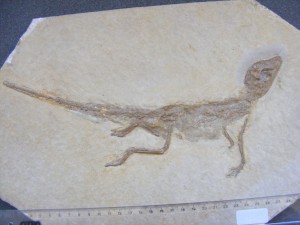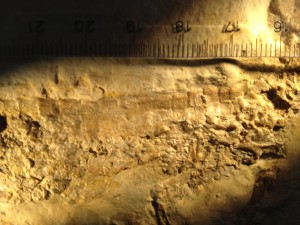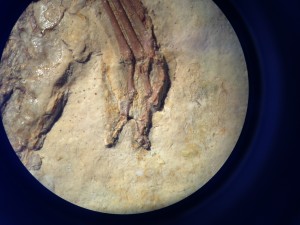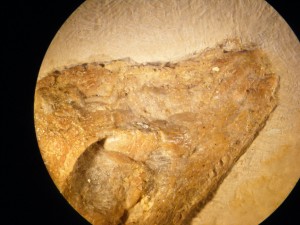My PhD consists of two parts. The first is investigating the dynamics of biodiversity across the Jurassic/Cretaceous interval about 145 million years ago. I want to see if when we consider the biases of the fossil record whether there was a ‘hidden’ mass extinction, and what were the ecological, physiological or environmental factors that correspond to this. This involves looking at turtles, birds, dinosaurs, marine reptiles, lizards, snakes, crocodiles and any other tetrapod group at the time – that’s anything with four feet, flippers or wings (see previous post for an update on all this jazz).

Evolutionary relationships of major tetrapod groups – many extinct, and many still with us today! Source.
The second part is a bit different, but sort of related. I’m revising the taxonomy (species-level identification) of a group of crocodiles called atoposaurids. These now-extinct crocs lived from the Late Jurassic right up until the end of the Cretaceous when a lot of other organism went extinct, such as marine reptiles and ammonites. The most awesome thing about them though, is that even when fully grown, they were often only less than half a meter long! Yep, dwarf crocodiles! I don’t care if they’re extinct, they’re cute, as far as fossils can get pretty much anyway. The other cool thing about them is that, although it’s uncertain presently, they may be related to the crocodiles which gave rise to modern ones (Neosuchia), so may provide clues as to how this lineage came to dominate and others did not. This is something I hope to shed a bit of light on at some point.
The last step I took in this side project of sorts was a trip to the collections in the Ludwig-Maximillan University in Munich. Not only is this the home of Richard Butler and his talented team, who work on similar aspects of Palaeo to me, and the European Geosciences Union, and my mates were having a stag do, but they have atoposaurids there! There’s a couple of casts of specimens there, some of which the original specimens have been lost during the war (the real reason why war sucks, obviously), but the one I most wanted to see was a lovely specimen of a croc called Alligatorellus beaumonti, which the original author of gave the subspecies name of bavarivcus to distinguish it from its French relative of slightly different proportions. Preserved on a slab of platy limestone, this was one squished individual, moderately preserved with quite a bit intact including the skull (really useful to vertebrate palaeontologists), and a great li’l specimen to learn the anatomy of these weird crocs. Quick thanks to Oliver Rauhut for granting me access to his collections so speedily.
Seeing as it hadn’t been looked at since 1971, and only then by some German dude who conveniently wrote the description in German, I figured it needed a fresh pair of eyes looking at it, using a pretty sweet microscope and with our current understanding of croc anatomy. There’s a few photos below, and I’m in the process of drawing the whole specimen as well as a few more detailed parts from photos of it, which I hope to use in a paper at some point in the future.

Full body shot of Alligatorellus beaumonti bavaricus (note that sub-species names are about the most useless thing ever created by taxonomists) (click for larger image; Copyright: Ludwig-Maximillian Museum)

Close up of the dermal body armour (osteoderms, or scutes) along the dorsal spine of Alligatorellus. They’re pretty mashed up, as is the general torso area. (click for larger, copyright Ludwig-Maximillian Museum)

Close up of the foot, taken down the microscope! (click for larger, copyright Ludwig-Maximillian Museum)

Close up of the skull, a bit distorted by the overlying rocks (you would be too..) (click for larger, copyright Ludwig-Maximillian Museum)

Even closer up of the skull, taken through the microscope – you can just about make out the peg-like teeth (click for larger, copyright Ludwig-Maximillian Museum)

Counter-part (impression) of Atoposaurus oberndorferi – the skeleton this belongs to is in the Netherlands! (click for larger, copyright Ludwig-Maximillian Museum)
The next step in this project is looking at specimens in Cambridge, Oxford, London (looked at before but need to go back – there’s a lot!), Dorset and the Isle of Wight, as well as internationally at numerous locations in Europe and Moscow where many under-studied specimens dwell (two grant apps for this just submitted!) Once I’ve looked up enough, I’ll be able to create a numerical matrix that computers can analyse to determine the relationships of the different species, something I’ll go into when I get around to doing it. I can use this as well to figure out how atoposaurids as a group fit in with the huge tree of crocodylomorphs. Hopefully as well, there’ll be a couple of new specimens I can describe, or identify things which were missed in previous studies. Watch this space!

Keith Tighe
Where about in the world was this fossil found?
Jon Tennant
This particular specimen was found in the lithographic limestones of Kelheim, in Bavaria, Southern Germany. It’s where quite a few of these specimens are from, but I suspect many have gone into private collections beyond my access.
Lorna Steel
Sometimes it’s worth spending some time translating descriptions of specimens in foreign languages- it will help you get started on your re-description, and it may alert you to features that you might otherwise not notice. There are various websites that are very useful for this. It’s also a good way to start picking up a foreign language, or at least the technical / palaeo words and phrases. Let me know when you want to see the crocs again.
Jon Tennant
Hey Lorna! 😀
Aye, the foreign descriptions are really informative – in this case, the only copy I had wasn’t scanned as text, so was an absolute funhouse to copy out and translate. Thanks to Google Translate for this one, I guess!
Thanks – I’ll let you know when I’m geared up to come again! (how cool is this, being alerted via a blog about collections visits?!?) 🙂 🙂
Lorna Steel
Many happy hours I’ve spent typing German text into Google Translate. You have to be careful to include the punctuation as it sometimes gives a slightly different meaning to the word! I’m working from home this week, so how cool is that? And contemplating setting up a blog and Twitter account for the NHM crocs to address the world… as if I have nothing better to do!
Richard Butler
If you don’t read German then why not do a good quality scan, PDF it, and then OCR it? If you do a good scan this can work very well, and then you can simply cut & paste into Google Translate (which is a bit crap for German by the way). Will save a lot of time…
Jon Tennant
I got a scan actually from someone on Wikipalaeo, but it wasn’t in OCR format unfortunately (something which you have to do at the scanning stage, right?) Normally I wouldn’t bother, but in this case it was an important article and the only way I had of translating it at the time. And yeah, I did notice a few er, minor discrepancies with the translated text – enough to go on, but a little shaky in places.
Richard Butler
If you have Adobe Acrobat Pro you can OCR any PDF using >Document >OCR Text Recognition. Quality of result will depend on scan quality though.
Jon Tennant
Also, totally YES to having the NHM crocs out there! The cephalopods, micropalaeo, and brachiopods do, and Paul B has his personal account, but it would be great to have something from deeper in the vert collections 🙂
Lorna Steel
I couldn’t believe it when Zoe told me how many followers the NHM_Brachiopoda had (?) so here goes with NHM Croc Blog. Maybe no tweeting just yet- I’m not prepared to buy a fancy phone until my old one has died!